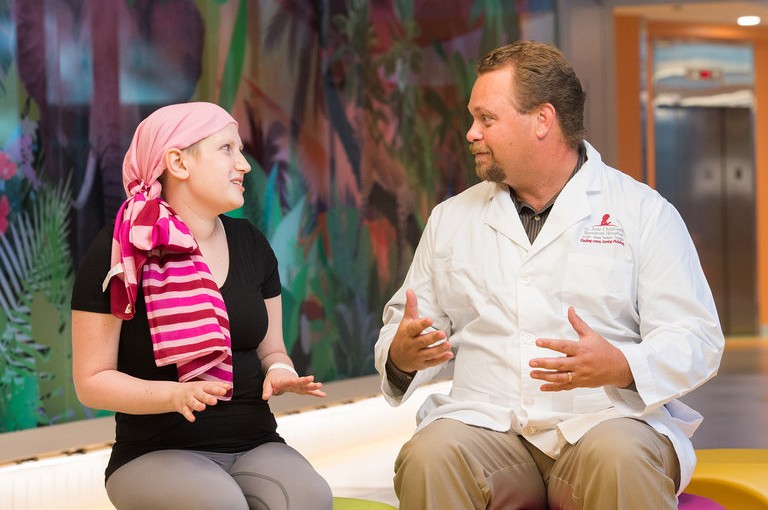By: Susan Gubar
Many people associate palliative care with hospice care, but medical professionals are offering it to children and adolescents living with cancer as well as to those dying from it.
In the process, they are redefining both palliative care and cancer care, focusing on helping each patient achieve the best quality of life possible.
About 15,780 American babies, children and adolescents receive a cancer diagnosis each year; approximately 1,960 die. Each one raises shocking questions about the suffering of the innocent.
The wrenching short story “People Like That Are the Only People Here: Canonical Babbling in Peed Onk” describes how alarming it is to enter the world of pediatric oncology (or “Peed Onk”). Its author, Lorrie Moore, portrays the incomprehensible languages, sterile environments and frightful technologies that estrange children and parents in hospitals. The story emphasizes the vertiginous loss of control patients’ families experience.
Children with cancer pose the problem of consciousness and agency. Can toddlers understand why they are receiving medicines that deplete them? Will teenagers discover the means to get through the tough challenges of postoperative recovery?
Back in 1978, one pioneering analysis of children with terminal disease suggested that very young kids comprehend their situation. In the book “The Private Worlds of Dying Children,” the anthropologist Myra Bluebond-Langner studied leukemia patients who ranged in age from 18 months to 14 years. By the age of 3, she argued, kids apprehend their prognosis in their own ways. With doctors, parents and siblings, they may engage in “mutual pretense,” for children intuit what their parents know and also what they want to hear: “The issue then is not whether to tell, but how to tell, in a way that respects the children and all of their many, often conflicting needs.”
Physicians now agree that whether or not these children are explicitly informed of their condition, they discern it — even if they want to protect themselves or their caregivers by not disclosing their understanding. They are therefore as vulnerable as adults to the fears that cancer spawns. And like adults, they must deal with invasive testing, surgery, radiation and chemotherapy as well as their miserable side effects.
But they may lack the resources that some adults have to find restorative activities to lessen the psychological stress and physiological distress of standard care.
The good news is that a growing number of doctors, nurses, social workers, therapists, psychologists, child life specialists and chaplains have been trained to provide the palliative care that pediatric patients and their families need.
In June of this year, St. Jude Children’s Research Hospital in Memphis held one of the first symposiums on the subject of pediatric palliative oncology. Through the efforts of Dr. Justin Baker, director of the Quality of Life and Palliative Care Division at St. Jude, a host of specialists explored how best to improve the quality of life for patients and their families from the time of diagnosis and throughout treatment.
Dr. Baker’s multidisciplinary team begins by handing incoming patients a stress ball that looks like a koala — their program is called Quality of Life for All (QoLA, pronounced koala) — with instructions to squish the toy if they are stressed and use the always available phone line to contact the staff (printed on the koala’s bottom), whenever anything is needed. Anything means anything.
In a phone conversation, Dr. Baker told me illustrative stories about two different adolescents. When one patient’s tumor recurred, Dr. Baker’s team asked her about the limited time left: “What are you hoping for?” Because she was by then in a private hospice suite within the hospital — one of several that bereaved parents at St. Jude’s helped design and raise funds for — he was able to fulfill her wish for a German shepherd puppy, which lifted her spirits during her remaining days. For her parents, Shadow, the pup, now serves as a legacy of their daughter’s love.
After a different patient confronted a secondary cancer brought about by treatment, she was rehospitalized for a bone-marrow transplant. She had severe gastrointestinal issues, and discussed her desolation about it with Dr. Baker daily. None of his efforts eliminated the problem immediately. But talking to a compassionate listener made her feel “like a new person” before and after she left the hospital to resume her life.
The key to pediatric palliative oncology is the presence of specialists with the time to pay attention to patients’ concerns: to assist with medications and appointment scheduling at home, to process conflicted emotions in play therapy involving music or art, to facilitate difficult conversations, decisions and pain management.
Palliative protocols aim to alleviate suffering. They address the side effects of standard care as well as the appalling threat of disability and mortality that plagues most cancer patients, not only those in a terminal state. When a child with cancer arrives at the hospital, no one can predict if he or she will be one of the 80 percent who survive. The solution at St. Jude: to offer palliative therapies for everyone who walks through the hospital’s doors.
This is where palliative care in pediatrics differs from palliative practices for adults. Most adults receive palliative assistance only in the final months of life. In the framework provided by Dr. Baker and his peers, however, palliative care should not be conflated with end-of-life care. They argue convincingly that children’s engagement in the process of treatment reduces the weight of uncertainty, anxiety and isolation for those who survive and those who do not and for their families as well.
Today, many children with cancer do not receive the comfort provided by integrating palliative with conventional care, and yet the goal is within sight. Could there be a worthier endeavor?
To read this article and more by Susan Gubar in The Clearity Portal, please click here to login.


